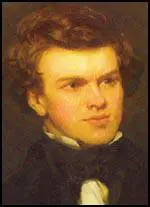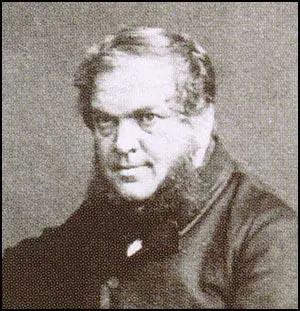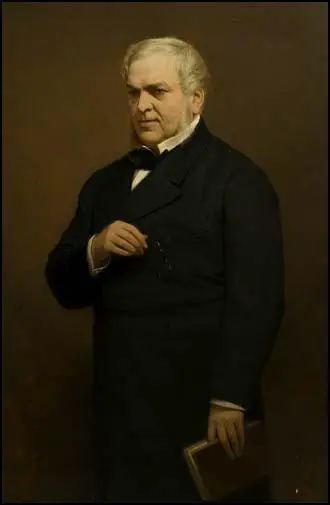John Forster

John Forster, the second of four children of Robert Forster, a butcher and cattle dealer, was born on 2nd April 1812, at Fenkle Street, Newcastle upon Tyne. John was brought up as an Unitarian.
Forster's father was not a successful businessman and an uncle, John Forster, paid for him to attend the Newcastle Royal Grammar School, where he became head boy. While at school he became very interested in the theatre and at the age of sixteen his melodrama Charles at Tunbridge , was performed at Newcastle's Theatre Royal.
In 1828 he went to Jesus College, but left the University of Cambridge after he discovered that it did not grant degrees to Unitarians. He moved to London where he studied law at University College under Thomas Chitty. During this period he was described as "a tall, ardent, noticeable young fellow... joyous, generous, sincere... the uncompromising advocate of all that was just, noble and good." He was a talented student but he decided not to become a lawyer: According to his biographer, James A. Davies: "The abandoning of Cambridge and a legal career - the latter later regretted—reflected his youthful determination to make his way in the literary world."
Claire Tomalin has argued: "The Forsters were Unitarians, subscribing to that admirable and bracing type of Nonconformity that encouraged rational thinking, held that social ills were not willed by God but created by human action, and believed in democratic government... John Forster grew broad-shouldered and intense, with a thatch of dark hair." His biographer described him as of being of medium height, dark-haired, with forceful, handsome features conveying great drive, and something of a dandy."
Forster was a regular contributor to the New Monthly Magazine and Englishman's Magazine . In 1832 he published Rhyme and Reason , a volume of poetry, and became drama critic of the The True Sun . Some of his articles were reprinted in The Times. He also embarked on brief biographical studies of leading figures of the English Civil War including Oliver Cromwell, Henry Vane, John Pym and John Hampden.
In 1835 Forster became the drama and literary critic, of The Examiner. The radical weekly magazine was edited by Leigh Hunt and gave support to reformists such as Henry Brougham, Francis Burdett, Robert Owen and Jeremy Bentham. As well as advocating social reform, the magazine published the poetry of young writers such as Percy Bysshe Shelley and William Hazlitt. The philosopher, John Stuart Mill argued that it was "the principal representative, in the newspaper press, of radical opinion".
Forster fell in love with the poet Letitia Landon. He proposed marriage and she accepted. However, he discovered stories circulating of her liaisons with various men. Forster questioned Landon about these stories. She replied by breaking off the engagement: "The more I think, the more I feel I ought not - I can not - allow you to unite yourself with one accused of - I can not write it. The mere suspicion is dreadful as death. Were it stated as a fact, that might be disproved. Were it a difficulty of any other kind, I might say, look back at every action of my life, ask every friend I have. But what answer can I give? I feel that to give up all idea of a near and dear connection is as much my duty to myself as to you."
Forster met Charles Dickens for the first time in 1836. The two men immediately became close friends. James A. Davies, the author of John Forster: a Literary Life (1983) has argued: "Forster's influence on the young Dickens was great, an important aspect being the widening of Dickens's social and literary circle through introductions to his friends... His hard-headed advice, generally concerned to prune excesses, remove impieties, and strengthen the moral force of narrative, reflected firm critical principles and an understanding of the mid-Victorian readership." Dickens greatly respected him as a literary critic and according to Forster, from October, 1837, "There was nothing written by him… which I did not see before the world did, either in manuscript or proofs."
Peter Ackroyd has pointed out in Dickens (1990): "He (Forster) was the same age as Dickens and, when they met, they would have already known or at least soon discovered how much they had in common... So the two young men impressed each other. They were alike, too, in other ways. They were both very precise and very punctual but, perhaps most importantly, Forster shared Dickens's own high spirits. He was well known for his loud laugh, and his equally boisterous energy and, like Dickens, he liked to perform impromptu comic dances. He loved the theatre, clubs, excursions, dinners and was in these days a Radical... which, if nothing else, suggests the moral rigour and direction of the politics of these young men."
Claire Tomalin , the author of Dickens: A Life (2011) has suggested: "Dickens was a rising star whom Forster believed to be a genius, and was ready to serve that genius, while Dickens realized Forster could be an invaluable adviser and supporter... This was was one of those life-changing friendships that arises when two young men - or women - meet and each suddenly realizes a perfect soulmate has been found. The world changes for both, they are amazed at their good fortune, greedy for one another's company, delighted by the wit, generosity, perception and brilliance that flashes between them. It is like falling in love - it is in fact a form of falling in love, without the overt sexual element. Dickens and Forster both liked women well enough, but it was almost impossible for women to give them the sort of good companionship they craved."
The two men would meet on a regular basis. On 26th July, 1837, Charles Dickens wrote to Forster: "My Missis is going out today, and I want you to take some cold lamb and a bit of fish with me, alone. We can walk out both before and afterwards but I must dine at home on account of the Pickwick proofs." On another occasion Dickens wrote to Forster: "Come to me, and don't be later than 11. I think Richmond and Twickenham through the Park, out at Knightsbridge, and over Barnes Common, would make a beautiful ride."
Forster often negotiated with publishers on Dickens' behalf. The publisher, Richard Bentley, described Forster as a bully who encouraged Dickens to be difficult and demanding. Forster told Bentley that Dickens was "the greatest master of prose fiction in this or any other language. Forster's negotiations with Chapman & Hall, resulted in him being given the post as their chief literary adviser.
Dickens found it extremely helpful that Forster reviewed his work in the The Examiner. For example, he described the scene where the hero is incarcerated in Fleet Prison from The Pickwick Papers in glowing terms: "The truth and power with which it is made are beyond all praise - so certain, so penetrating, and so deeply-aimed, and yet, at the same time, so obvious and familiar, are the materials employed. Every point tells, and the reality of the whole is wonderful. We place the picture by the side of those of the greatest masters of this style of fiction in our language, and it rises in the comparison... We reccognize in this fine writer a maturing excellence."
Dickens wrote a letter to Forster thanking him for the article: "I feel your rich, deep appreciation of my intent and meaning more than the most glowing abstract praise that could possibility be lavished upon me. You know I have ever done so, for it was your feeling for me and mine for you that first brought us together, and I hope will keep us so, till death do us part. Your notices (reviews) make me grateful but very proud; so have a care of them, or you will turn my head."
Letitia Landon married George Maclean, governor of the Gold Coast on 7th June 1838. She went to live with him in Africa. Forster was devastated when he heard that four months later she committed suicide by drinking a bottle of prussic acid.
In 1838 John Forster moved to 58 Lincoln's Inn Fields, where he remained for the next twenty years, where he gradually expanded into more rooms on the same floor and above, filling each one with his growing collection of books. James A. Davies has commented: "Though he had forthright opinions and was often difficult, rude, bad-tempered, bullying, and pompous... and so made enemies or disrupted friendships with fierce quarrels, Forster's friends knew that, essentially, he was tender-hearted, affectionate, loyal, convivial, and generous."

In January 1846, Charles Dickens became editor of The Daily News for a salary of £2,000 a year. Dickens hired Forster and Douglas Jerrold to write political leaders for the newspaper. He also employed John Dickens to take charge of reporting staff. The plan was to take on The Times, which had a circulation of 25,000 copies and sold for sevenpence. Dickens' newspaper sold 10,000 copies at the beginning but sales fell sharply afterwards and settled at around 4,000.
Dickens soon got bored with running a newspaper and in February, 1846, he managed to persuade Forster to take over the editorship of The Daily News. He wrote to Emile De La Rue: "I have handed over the editing of the paper (very laborious work indeed) to Forster; and I am contemplating a new book... The Daily News is a great success... but I am not quite trustful in some of the people concerned in its mechanical and business management." Dickens continued to write for the newspaper, including a passionate article calling for the abolition of capital punishment. Forster disagreed with the decision to increase the price of the newspaper and resigned as editor in November, 1846.
In the early 1840s Charles Dickens began work on an autobiography. He sent the manuscript to Forster but changed his mind about the book and destroyed what he had done. In 1848 he decided that he wanted Forster to become his biographer and gave his old friend several long interviews about his life.
Forster astonished his friends by becoming engaged to Eliza Ann Colburn (1819–1894), the widow of the publisher Henry Colburn and the daughter of Captain Robert Crosbie. Dickens claimed that when he heard the news "I lay down flat, as if an Engine and Tender had fallen upon me". They were married at All Saints' Church, Upper Norwood, on 24th September 1856. His wife was extremely wealthy and the couple were able to live in Palace Gate House in Kensington. The marriage proved happy, though childless.

In 1861 Forster was appointed as commissioner in lunacy at a salary of £1500 per annum. He continued to write and his books included Sir John Eliot: a Biography (1864), Walter Savage Landor (1869) and The Life of Jonathan Swift (1875).
After the death of Charles Dickens he worked on his biography. The first volume of The Life of Charles Dickens was published in 1872. As Claire Tomalin has pointed out: "The revelations about Dickens's childhood, Forster's memories of over thirty years and his quotations from intimate letters gave his work an authority no one else's could have matched. On page after page he brought Dickens alive with... his energy, charm and brilliance and also his anger and obsessiveness. He presented a genius but not a saint, and he suggested that the same forces that had driven him to achieve so much also drove him to break up his life - that the young Dickens's sense that his will could achieve everything he set out to do meant that, in the later years, the same strength of will became the agent of his own destruction."
Henry Fielding Dickens commented in his book, The Recollections of Sir Henry Dickens (1934): "His Life of my father has, I know, been severely criticised in some quarters as containing too much of Forster and too little of Dickens. In fact, it has been jokingly alluded to by a well-known judge of considerable literary attainments as Dickens's Life of Forster. I have always thought this criticism altogether undeserved. Forster must inevitably, by reason of his close connection with Dickens, have taken a prominent place in the picture."
John Forster, who suffered greatly from bronchitis and from rheumatism, died at Palace Gate House on 1st February 1876. He was buried at Kensal Green Cemetery five days later.
Primary Sources
(1) John Forster, The Examiner (2nd July, 1837)
The truth and power with which it is made are beyond all praise - so certain, so penetrating, and so deeply-aimed, and yet, at the same time, so obvious and familiar, are the materials employed. Every point tells, and the reality of the whole is wonderful. We place the picture by the side of those of the greatest masters of this style of fiction in our language, and it rises in the comparison... We recognize in this fine writer a maturing excellence.
(2) Charles Dickens , letter to John Forster (2nd July, 1837)
I feel your rich, deep appreciation of my intent and meaning more than the most glowing abstract praise that could possibility be lavished upon me. You know I have ever done so, for it was your feeling for me and mine for you that first brought us together, and I hope will keep us so, till death do us part. Your notices (reviews) make me grateful but very proud; so have a care of them, or you will turn my head.
(3) Peter Ackroyd , Dickens (1990)
He (Forster) was the same age as Dickens and, when they met, they would have already known or at least soon discovered how much they had in common... So the two young men impressed each other. They were alike, too, in other ways. They were both very precise and very punctual but, perhaps most importantly, Forster shared Dickens's own high spirits. He was well known for his loud laugh, and his equally boisterous energy and, like Dickens, he liked to perform impromptu comic dances. He loved the theatre, clubs, excursions, dinners and was in these days a Radical... which, if nothing else, suggests the moral rigour and direction of the politics of these young men.
(4) Claire Tomalin , Dickens: A Life (2011)
Dickens was a rising star whom Forster believed to be a genius, and was ready to serve that genius, while Dickens realized Forster could be an invaluable adviser and supporter... This was was one of those life-changing friendships that arises when two young men - or women - meet and each suddenly realizes a perfect soulmate has been found. The world changes for both, they are amazed at their good fortune, greedy for one another's company, delighted by the wit, generosity, perception and brilliance that flashes between them. It is like falling in love - it is in fact a form of falling in love, without the overt sexual element. Dickens and Forster both liked women well enough, but it was almost impossible for women to give them the sort of good companionship they craved.
(5) John Forster, The Life of Charles Dickens ( 1872 )
These are interesting intimations of the care with which Dickens worked; and there is no instance in his novels, excepting this (Tale of Two Cities), of a deliberate and planned departure from the method of treatment which had been pre-eminently the source of his popularity as a novelist. To rely less upon character than upon incident, and to resolve that his actors should be expressed by the story more than they should express themselves by dialogue, was for him a hazardous, and can hardly be called an entirely successful, experiment. With singular dramatic vivacity, much constructive art, and with descriptive passages of a high order everywhere (the dawn of the terrible outbreak in the journey of the marquis from Paris to his country seat, and the London crowd at the funeral of the spy, may be instanced for their power), there was probably never a book by a great humourist, and an artist so prolific in the conception of character, with so little humour and so few rememberable figures. Its merits lie elsewhere. Though there are excellent traits and touches all through the revolutionary scenes, the only full-length that stands out prominently is the picture of the wasted life saved at last by heroic sacrifice. Dickens speaks of his design to make impressive the dignity of Carton's death, and in this he succeeded perhaps even beyond his expectation. Carton suffers himself to be mistaken for another, and gives his life that the girl he loves may be happy with that other; the secret being known only to a poor little girl in the tumbrel that takes them to the scaffold, who at the moment has discovered it, and whom it strengthens also to die.
(6) Henry Fielding Dickens , The Recollections of Sir Henry Dickens (1934)
His Life of my father has, I know, been severely criticised in some quarters as containing too much of Forster and too little of Dickens. In fact, it has been jokingly alluded to by a well-known judge of considerable literary attainments as Dickens's Life of Forster. I have always thought this criticism altogether undeserved. Forster must inevitably, by reason of his close connection with Dickens, have taken a prominent place in the picture.
